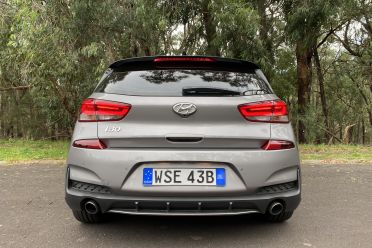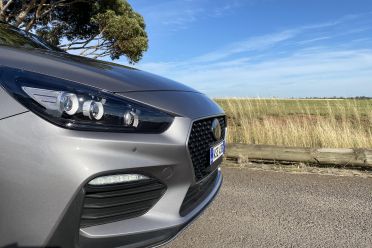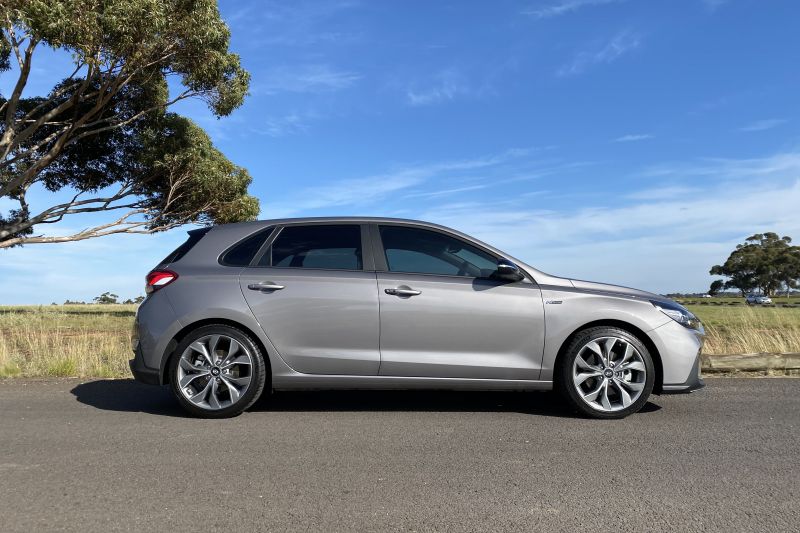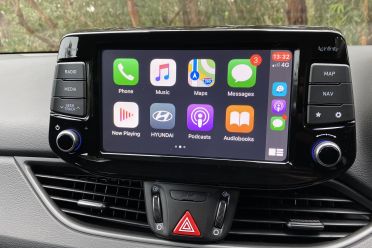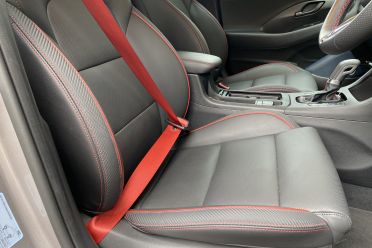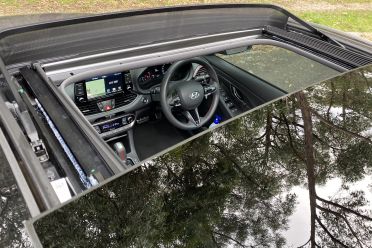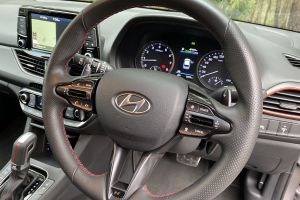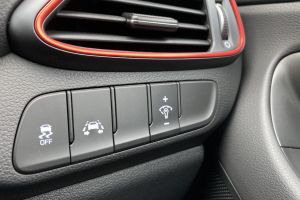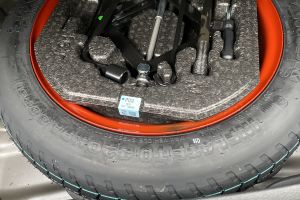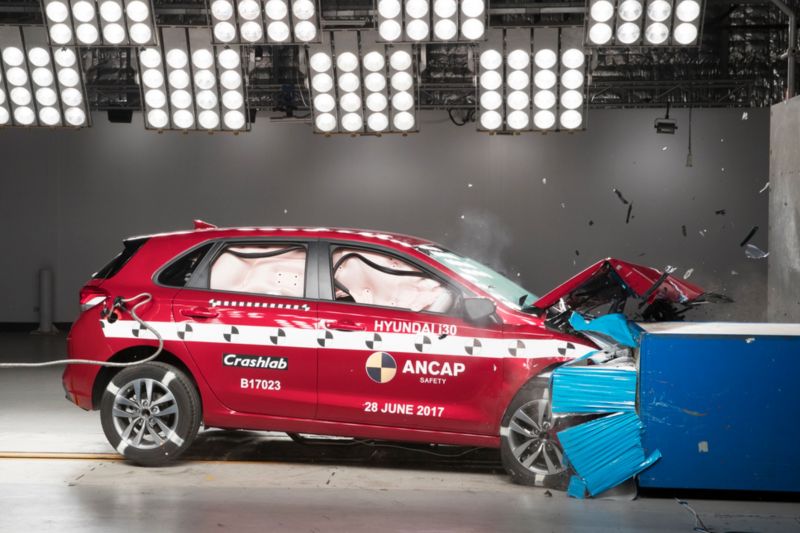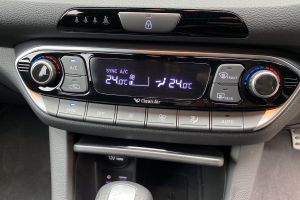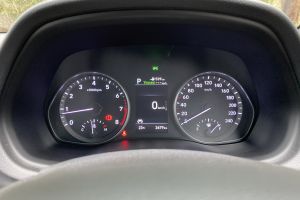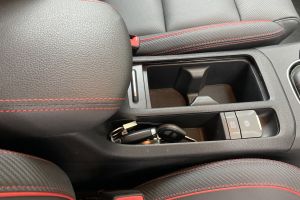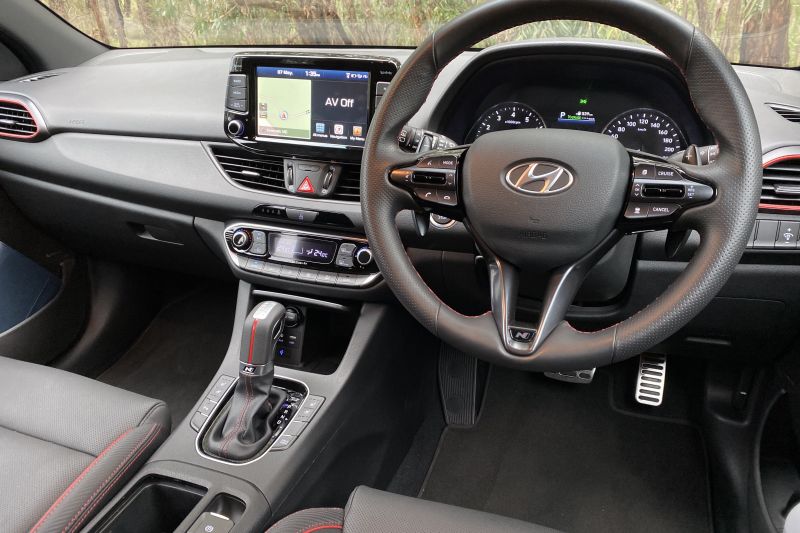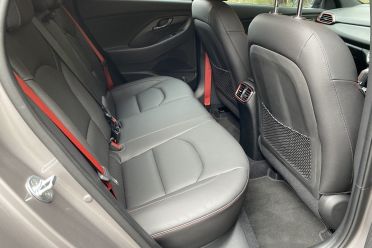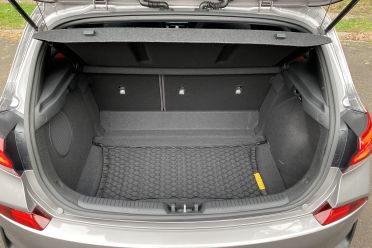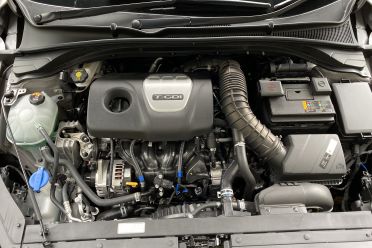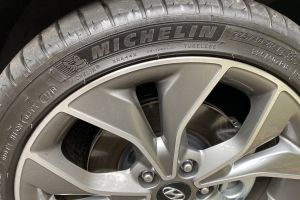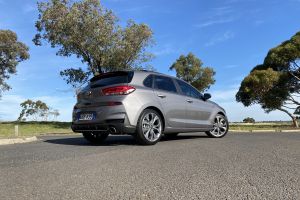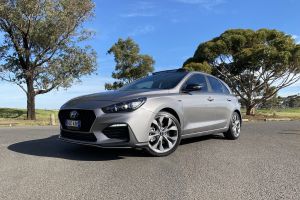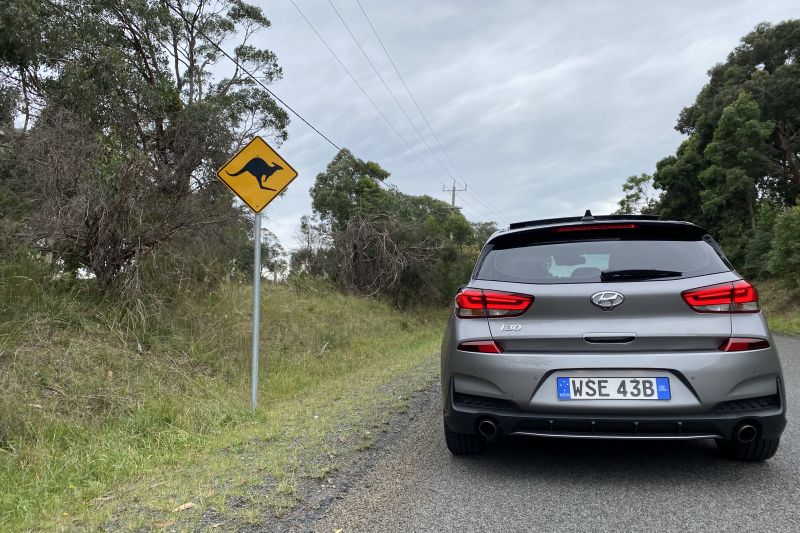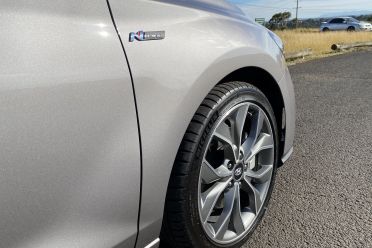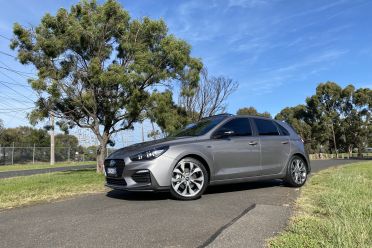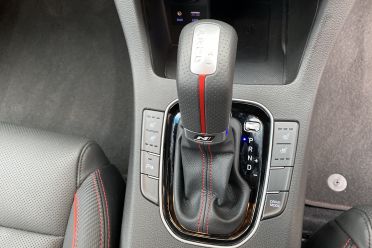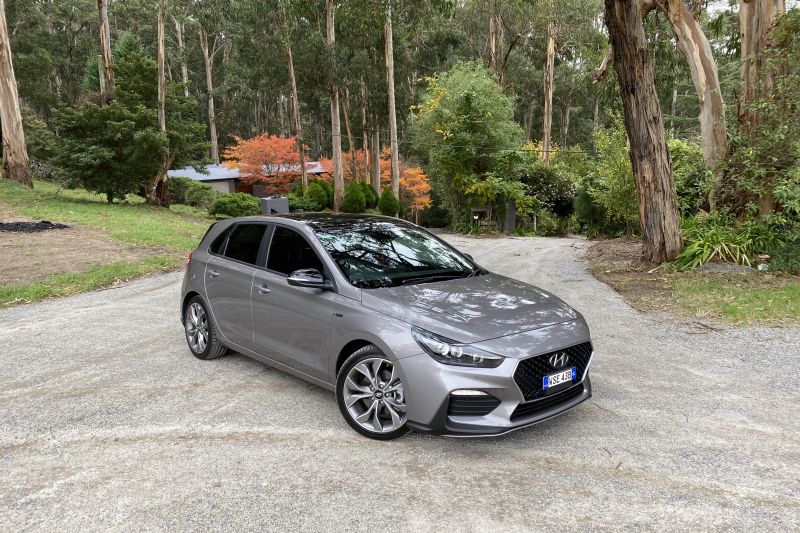A dual-clutch automatic version of the Hyundai i30 N hot hatch is coming, but it’s not here yet, which means the sprightliest and most luxurious i30 derivative with a self-shifter is the version tested here.
The Hyundai i30 N Line Premium was once known as the SR Premium, and it pitched as a sort-of hot version of the company’s staple small car that’s not necessarily as compromising for the daily driver.
From a consumer angle, there’s an updated i30 due late in 2020 that sports a new grille design, a more contemporary centre screen and digital instruments. Which means now might be a good time to find a bargain on what remains a very compelling car.

How much does the Hyundai i30 N Line Premium cost?
The i30 N Line Premium is priced from $35,590 before on-road costs.
For comparison purposes the less-well-equipped i30 N Line costs $30,040 before on-roads with the DCT automatic, the less powerful i30 Premium $33,370 before on-roads, and the manual-only i30 N Performance (a ‘proper’ hot hatch) costs $41,400 before on-road costs.
In terms of big-selling competitors, there’s the Toyota Corolla ZR that tops out at $33,635, the mechanically related Kia Cerato GT at $33,490, Honda Civic RS for $33,540, Ford Focus Titanium for $34,490, and Volkswagen Golf Highline at $34,490.
The Hyundai’s advantage is its potent powertrain that, Cerato excepted, leaves these competitors’ outputs in the shade.
How much should I pay?
At the end of the day, the price you pay at the dealership will be dependent on a number of factors such as when you want to buy (is the dealership chasing sales?), the age of the model you’re purchasing (is a new generation model being launched soon) and of course your strength as a negotiator.
What do you get?
On the outside there’s 18-inch alloy wheels wrapped in sticky Michelin Pilot Sport 4 tyres (with a space-saver spare), auto-folding side mirrors, a subtle body kit and mesh grille insert, dusk-sensing LED headlights, daytime running lights, a proximity key fob with push-button start, and a huge panoramic glass sunroof.
Inside you get leather seats with power adjustment for the driver, heated and ventilated front seats for both driver and passenger, dual-zone climate control with ioniser and filter, LED cabin lighting, a Qi wireless smartphone charging pad, black headlining, and rain-sensing wipers.
Infotainment is displayed on an 8.0-inch touchscreen with satellite-navigation, SUNA live traffic updates, Bluetooth, DAB+ radio, wired Apple CarPlay and Android Auto, and a seven-speaker Infinity sound system. The voice control system requires a phone to be connected – e.g. with Apple devices it relays Siri.
You also get access the Hyundai Auto Link Premium smartphone app. Using this you can remotely check your car’s status (mechanical health check, economy, refuelling history, emissions etc), find where you car is parked, schedule a service, geofence, or start the car, turn on the climate control, or sound the horn – all remotely.
In short, it’s rare to find a sub-$40,000 car with a panoramic glass sliding roof, heated and ventilated seats, and full LED lighting.
Is the Hyundai i30 N Line Premium safe?
Yes. You get seven airbags, three rear-seat top-tether points, and two Isofix anchors. You also get parking sensors at both ends, a reversing camera display, and tyre-pressure monitoring system.
Driver-assistance features include:
Autonomous emergency braking (AEB) that works at urban and interurban speeds and can detect pedestrians, lane-keeping aid with steering assist, and active cruise control with stop & go.
Crash tester ANCAP awarded the i30 a five-star score in 2017, achieving 35.01 points out of 37. It subsequently retained five stars after an audit test.
What is the Hyundai i30 N Line Premium like on the inside?
Hyundai has emphasised the N Line Premium’s sporty pretensions by using red for the stitches, seat highlights, seat belts, and vent surrounds. There are also alloy-plated pedals and a nice steering wheel with simple buttons.
The ergonomics are hard to fault given the plethora and seat and wheel adjustments you can choose, and there are also plenty of storage areas including a large closing section ahead of the (good quality) gear shifter, sizeable door bins, a sliding cupholder cover, and centre console.
Unlike the sleeker Mazda 3, for example, the large side windows make the i30 quite easy to see out of. Nor are the A-pillars needlessly thick.
Behind the wheel there’s a fairly basic analogue instrument cluster with a small TFT screen between them, on which you can use a digital speedo or check trip data.
The centre touchscreen display is flanked by shortcut buttons and a volume dial, and runs Hyundai’s intuitive software. The navigation system is great and subject to annual upgrades, the camera resolution is crisp, and phone mirroring is never a bad thing.
However, there’s nothing overly flashy or modern about it. There’s a wireless charging pad I guess, but only one USB port, no head-up display (like the Corolla or Mazda 3 units), no digital instruments, nor a screen as large as the Hyundai Ioniq hatchback’s.
The update due at year’s end, however, will rectify most of these issues and really modernise the slightly dated design.
Big sunroof comes standard
It really improves the ambience, and rest assured Hyundai has kept the body rigid
The build quality feels solid and should last the test of time, though the material quality is a little ‘meh’, particularly the hard and drab plastics along the transmission tunnel and lower dash.
While the red highlights add levity, it’s all a little bland to behold. There are few ‘surprise and delight’ features, or contrasting trims, or particularly solid switches or dials. It’s fine. But ‘premium’ as the badge sort of suggests? Not really. Notwithstanding the list of standard features…
Unlike its Mazda 3 and Toyota Corolla hatch competitors, the back seats are useable for most adults. The backs of the front seats are hard and kid-proof, there are air vents, red seatbelts, and acceptable knee-room and shoulder room for anyone below 190cm.
Having a giant sunroof to look out of helps the ambience no end, although I did notice my 194cm height did render headroom less generous than I’d like, particularly in the back row. Therein lies one trade-off for a sunroof.
The boot space is a generous 395L, and there’s a temporary space-saver spare under the floor. You get a cargo net and a solid cover thrown in. In terms of space and usability, it beats the pokey Corolla and Mazda 3 hatchbacks, but doesn’t match the hugely capacious Honda Civic.
What’s under the bonnet?
The 1.6-litre turbocharged petrol engine is familiar from other cars such as the Hyundai Veloster and Tucson, and Kia’s Cerato GT.
It outputs 150kW of power at 6000rpm and 265Nm of torque between 1500 and 4500rpm, helps the car dash to 100km/h in around 7.2 seconds on a clean getaway, and has combined-cycle fuel consumption (using 91 RON) of 7.1 litres per 100km.
While the lower-grade i30 N Line can be had with a six-speed manual gearbox option, the sole transmission in the Premium is a seven-speed dry-clutch DCT with manual mode.
How does the Hyundai i30 N Line Premium drive?
The turbo engine doesn’t really inspire with its soundtrack, certainly not like the hardcore i30 N does with its active exhaust.
But it gets up and goes nicely, with effortless rolling response thanks to the full whack of torque available near idle, and a DCT enabling rapid shifting.
At the same time, around town there’s no doubt the DCT is a little harder to get along with than a conventional torque-converter auto, requiring a more gradual throttle input to ensure smoothness. The presence of Auto Hold, and hill-hold assist, helps.
This car is more affordable than proper hot hatches like that i30 N, plus the Volkswagen Golf GTI and myriad others, and while neither as sonorous or outright quick, certainly sits above most price-point competitors for punchiness.
Unlike entry-grade i30s, the N Line Premium has a more sophisticated multi-link independent rear suspension setup, alongside fixed dampers.
Rather than just take the stock car, Hyundai’s Australian-based team of engineers retune the springs, shocks, bushes, and bars on all its vehicles to better suit local roads, and true to form the way the i30 isolates you from sharp inputs is commendable.
Moreover, despite the glass roof, the body feels rigid and strong (made from Hyundai’s own in-house steel, believe it or not) and the body control through corners is tied-down. This car feels quite agile, and the unusually resistant steering helps at speed.
The fitment of Michelin Pilot Sport tyres ensures grip rarely falls short of what you need it to be, though there is no shortage of tyre ‘roar’ that permeates the cabin on coarse surfaces and smoother surfaces alike.
There are various driving modes from eco to sport that change the transmission shift points, steering resistance, and throttle response. But all the latter really means is heavier steering and a DCT that holds low ratios longer, without causing any cackle or burble on the overrun for fun.
The driver assistance functions all played their part, though the lane-departure alert and steering system only nudges you away from road lines rather than trying to keep you centred like Toyota’s Lane Trace system. Small gripes.
How much does the Hyundai i30 N Line Premium cost to run?
Hyundai’s warranty is active for five years and has no distance limit, with roadside assist.
The first three services are capped at a reasonable $269 per visit, however unlike the i30’s naturally-aspirated engine option and many competitors, the intervals are either annual or 10,000km.
Given the average commuter exceeds 10,000km per year, it’s likely you’ll be servicing your vehicle more regularly than many other options would require.
CarExpert’s Take on the Hyundai i30 N Line Premium
The i30 N Line Premium does many things well. It looks great, handles corners with veracity thanks in large part to its bespoke tune and tyres, and is absolutely spilling over with features. And who doesn’t love a panoramic glass roof that neither squeaks or causes undue body flex?
The MY21 update should enhance the infotainment, connectivity and instrumentation, though right now it’s a smidgeon dated. There’s also short servicing intervals, marked road noise that deducts from the ‘premium’ in its name, and a price point that it must be said isn’t entirely cheap too.
But as a sprightly daily driver it’s a damn solid offering, and one that’ll soon be in runout. Bargain time.

